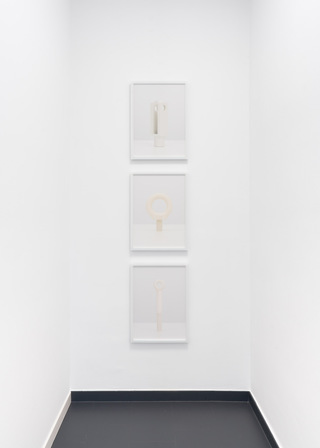Carsten Becker
Show Norm en
Norm
Carsten Becker
Galerie Konstanze Wolter, Theaterstr. 58, Chemnitz, Germany
Feb 7 – March 26, 2022

Standards are understood as order and clarity. However, reality is much more complicated. In his work series DIN (2019–2022), Berlin-based artist Carsten Becker exposes the political, military, and emotional implications of standardized commodities.
December 22, 1917: On the initiative of the Königliches Fabrikationsbüro für Artillerie (Royal Manufacturing Office for Artillery), the Normenausschuss der deutschen Industrie (Standardisation Committee of German Industry, DIN) is founded in Berlin. The economy was not the only one to prosper; in the fourth year of war, the German armed forces were the most important customer of this efficiency-enhancing institution.
At the center of his conceptual work DIN, Carsten Becker places standard parts developed for military and economic purposes. In macro shots, Becker directs our gaze to the clear forms of these mass-produced objects. Using the medium of photography, he transfers the parts into the apparent infinity of a white space. Thus, removed from their context of use, the contours, curvatures, oscillations, grooves, lines, and corners of the objects emerge. Like industrial objets trouvés, the archetypal Vichyform bottles reveal the elegance of their soaring form. On the other hand, they conceal that they were standardized and named in 1942—a time when the Nazis had control over the French standardization body AFNOR and General Petain’s puppet government resided at the spa town of Vichy. Others, such as the curved Schwenkscheibe and the smooth Kugelknopf, radiate a sublime calm in their abstract unrecognizability.


Becker’s color palette contributes to this impression; through it, he turns the mass-reproduced utilitarian objects into unique specimens. Now useless through Becker’s treatment, they diffuse into the sphere of art. Their matte colors absorb the light, so that the razor-sharp outlines make the standard parts appear flat. Within the body, however, the colors draw the eye to the three-dimensional shadows and points of light of these everyday sculptures.
Becker varnished the representatives of these universal forms with hues from the German color collection RAL, named after the Reichsausschuss für Lieferbedingungen (Reich Committee for Delivery Conditions), which was founded in 1925. To this day, it lists colors used by German government agencies and the military. Although designed for infinite reproduction, some of these RAL colors came to an abrupt ending: for example, RAL 4000, the violet hue of the luxury train “Rheingold” on Becker’s Einheitsglas, and dark yellow, the color of the photographed Kugelknopf used for camouflage against infrared night vision devices, were removed from the color register after World War II.
Through their silent accomplices, Carsten Becker seeks to understand the materiality of World War II, leaving scars not only in his family. With the perfection of his photographs and the beauty of efficiency, the artist uncovers an oppressive substructure. His works expose the entanglements of the modernist form discourses with the horror of the Holocaust; they show the intertwinement of color theory with the totalitarian regime of National Socialism. In Carsten Becker’s work, forms and colors are not universal and apolitical. They are components of the visual, social, and political rhizomes that again come to light in the day-to-day life of the 21st century, e.g., as “Vichyform.”
Anika Reineke



Serial
DIN
Space
Galerie Konstanze Wolter
JavaScript is turned off.
Please enable JavaScript to view this site properly.